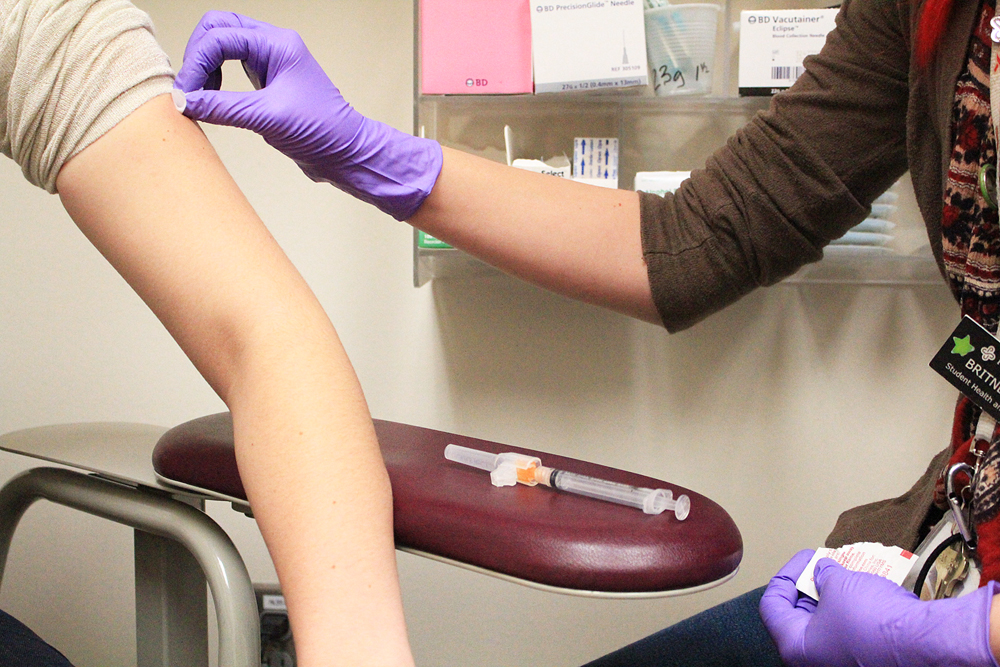The start of winter term marks the beginning of another significant time of year—cold and flu season. This year is no different, with an abundance of different viruses going around, including the return of the dreaded swine flu—now more commonly referred to by its proper name, H1N1.
A recent KATU news article reported that though this round of H1N1 is nothing like the last that killed nearly 300,000 people worldwide in 2009, a large number of Oregonians have been admitted to hospitals this flu season, many with H1N1.
There are three types of flu viruses: influenza A, influenza B and type C. H1N1 is a subtype of influenza A. At Portland State, the test available at the Center for Student Health and Counseling does not distinguish between the two types of influenza, so it’s unclear if any students have been diagnosed with H1N1.
“We treat it all the same,” said Tara Gardner-Brown, a family nurse practitioner at SHAC. “It’s still the flu. [In] the cases we’ve had, students had a really high fever and felt very bad.”
However, one important thing to distinguish is whether the illness is the common cold or the flu.
“Looking at the differences between them, it’s difficult for anyone to determine how you know it’s the flu versus a regular virus,” Gardner-Brown said.
The symptoms can be very similar, but there are a few differences that can make the determination easier. One of the most significant is the high fever, which is a fever around 101 degrees.
“Not everyone gets that, however, so there’s that little caveat,” Gardner-Brown said. Symptoms like body aches, headaches, nausea and coughing are also signs it could be the flu instead of a cold.
The other main difference is that a cold will oftentimes give a warning before hitting in full force.
“You can usually tell when you’re starting to feel under the weather—you have a runny nose, you’re sneezing—you know it’s coming,” Gardner-Brown said. “But the flu gives you the feeling like it hit you like a truck overnight; you were fine, then all of a sudden you’re really sick.”
Armaan Roshani, a sophomore in computer engineering, is currently fighting off the flu. His sister was diagnosed with H1N1 right around Christmas time.
“I don’t know if what I have is H1N1, but it is most likely some sort of flu because the first onset of symptoms was body aches, headaches and some nausea, which you don’t really get with a cold,” Roshani said.
Roshani’s sister was actually diagnosed with both H1N1 and Influenza B at the same time.
“I didn’t have a lot of contact with her at that point, as I’m sure she was trying to stay away from everyone,” Roshani said. “The experience was more like a cold with body aches than the flu, even though she definitely had both types of the flu.”
Gardner-Brown pointed out that it’s hard to know how the flu will affect each individual person. Health problems like asthma and diabetes can exacerbate flu symptoms and can also put people at a higher risk of catching it.
The flu usually entails about three or four days of high fever, but carriers can be contagious for a full day before any symptoms show. They then continue to be contagious for up to five days, regardless of whether they are feeling better.
“It’s really important that students are staying home if they have a fever. We really consider a fever to be around 101 degrees, so if you‘re having a fever, you’re sick, you’re coughing—stay home until your fever has been gone for 24 hours,” Gardner-Brown said.
If a fever persists, or comes back for another couple days, Gardner-Brown suggests going to a doctor, because that’s a sign that it’s more than a minor flu or cold.
“If you [don’t start] feeling better after three to four days, and you’re feeling like you’re going downhill—you’re getting crazy fevers and coughing really hard—you should see someone, because there can be complications and it can get really bad,” Gardner-Brown said. “The people who are getting super sick with the H1N1 flu are those that are ignoring it and just pressing on and pressing on and not doing anything about it.”
Dr. Mark Bajorek, the medical director for SHAC, shared Gardner-Brown’s sentiments, stating that the best way for students to treat H1N1 is “at times Tamiflu, largely rest, fluids and hand-washing.”
The flu is spread mainly by droplets exiting the mouth or nose while sneezing, coughing or talking. These droplets can travel up to six feet.
Roshani said that his mother has spent time in Japan, where surgical masks are common during cold season.
“I live with her at the moment, so she’s been wearing one and I’ve been wearing one as well,” Roshani said. “Who knows if it is going to lower the chance that she will get what I have, but it should definitely help.”
Roshani highly encourages other students to wear masks, which can be found at SHAC and are free to students. “It looks annoying and freaks people out because it’s not in our culture, but it will really help if people that have the flu are wearing one.”
Angela Abel, the marketing and communication coordinator for SHAC, said in an email that even though SHAC is currently out of the flu vaccine, there are still places to get the shot. This year’s vaccine covers the H1N1 strain.
“We only get an allotted amount of flu vaccinations each year. We administered 500 [doses] throughout fall term,” Abel wrote. “Students seeking a flu vaccination right now should visit [flushot.healthmap.org] or [getaflushot.org].”
For more information, visit the SHAC website at pdx.edu/shac/ or call 503–725-2800 to make an appointment.






